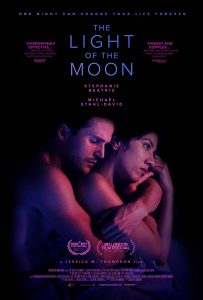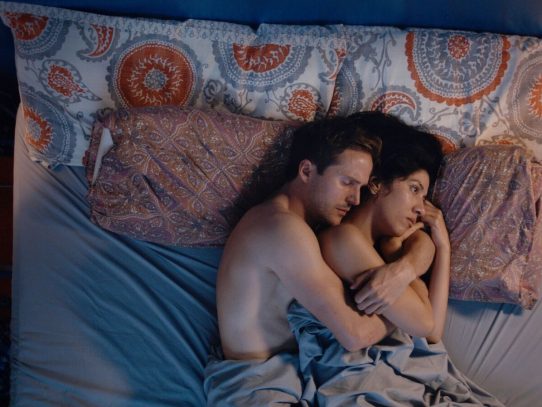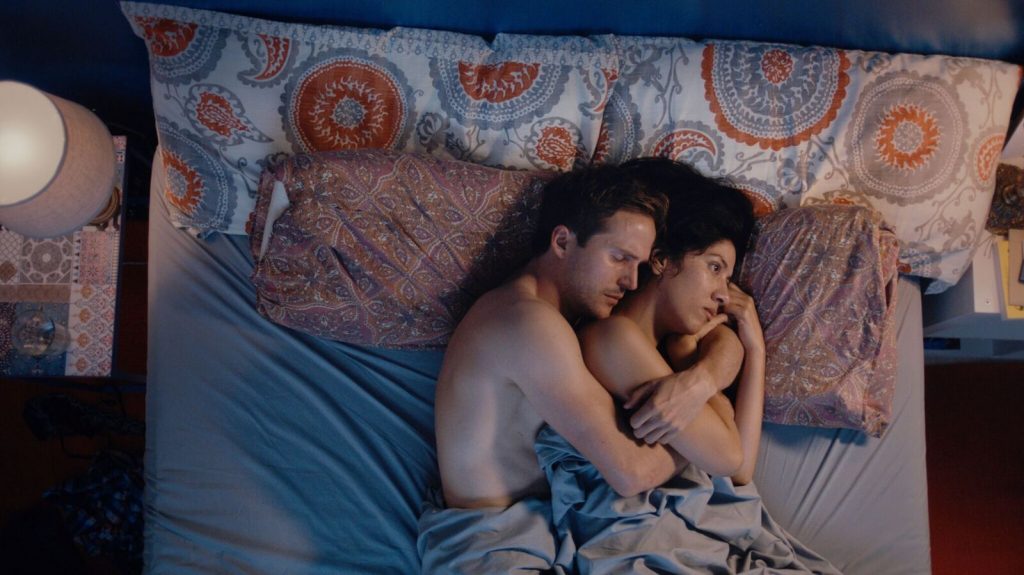 Read FF2 Media’s Q&A with director Jessica M. Thompson HERE.
Read FF2 Media’s Q&A with director Jessica M. Thompson HERE.
Directed, written and co-produced by Jessica M. Thompson, The Light of the Moon is about rape and the traumatic effect it has not only on the victim herself, but on the relationships to the people in her immediate surroundings. Unfortunately, The Light of the Moon’s immensely important topic, and educational aspirations, are undermined by stereotypical visuals and lacking lead performances. (MJJ: 2.5/5)
Review by FF2 Intern Malin J. Jornvi with Lindsy Bissonnette in the Coach Corner
The Light of the Moon is an educational attempt at portraying the effect rape has on the victim and the people close to her. From the moment right before the rape, when the protagonist Bonnie (Stephanie Beatriz) walks home alone from the bar with blasting music in her headphones and the complete overprotective transformation of her boyfriend Matt (Michael Stahl-Davis), to her demeaning encounter with the judicial system and her continuous refusal to see herself as a victim at all—The Light of the Moon portrays the many incorrect ways to cope with sexual assault. With the consecutive stereotypes, it is a story—to a large extent—already told, yet the social issue itself is far from resolved. Thompson’s film wants to challenge the grander picture, especially through the many Q&A sessions following the New York screenings with panelists ranging from UN Women to PurpLE Clinic, but, regrettably, the social approach is hampered by the instrument, the film itself.
New York is a popular location shoot; almost any TV-series or feature film finds a reason to include city footage in some way or another. It is understandable: New York is cinematically appealing and carries many cultural connotations. However, the setting cannot be the star. The Light of the Moon’s use of Brooklyn (mainly hipster-gentrified Bushwick), gets tiresome in its attempt to locate the story, scene after scene, to this trendy place: What is the point of yet another brick wall façade or the multiple two-second cuts of the Williamsburg bridge? 
The use of New York rapidly becomes stale, and unfortunately, Thompson’s film continues along this worn-out line. There’s the edgy music, the gay friend, the cozy Brooklyn apartment, the relentlessly curled and styled hair, the boyfriend’s six pack. And the completely unbelievable acting. For two actors with quite substantial credits, it is surprising how the relationship between the two lead characters is simply non-existing; there is no chemistry justifying their attempt to stay together. Then there is the noticeable anticipation of lines, the lack of reaction to crucial moments, and also the countless number of tongue stretches/twisters by Stephanie Beatriz that, frankly, becomes distracting. Fascinatingly, the only parts I did found realistic were the couple’s two sex scenes (that is, realistic for any other couple, not a couple in the process of healing from a sexual assault trauma).
Despite the stereotypes and acting, The Light of the Moon raises some interesting points that could have been further explored, like when a waitress (Jessica M. Thompson’s cameo appearance) notices Bonnie’s bruised face and offers to report the assumed domestic violence. An even more important example is the unexplored (or implicit) reason for Bonnie’s refusal to break down: Is there some kind of shame involved? Is she simply a stone? Thompson’s film does not tell. Instead, Light of the Moon adds another cliché shot—Bonnie running across Williamsburg bridge (i.e. healthily overcoming the hardship)—and leaves us with another rape story frustratingly inept at helping us learn how to tackle the social structures that continues to allow certain individuals to grow up into sexual offenders, or how to adequately support their victims.
© Malin J. Jornvi (11/5/17) FF2 Media
Top Photo: The Light of the Moon film poster.
Middle Photo: Bonnie walking home alone at night with headphones on.
Bottom Photo: Bonnie and Matt spooning in bed.
Photo Credits: Imagination Worldwide.
Q: Does The Light of the Moon pass the Bechdel-Wallace Test? 
Yes.
Though all conversation topics are directly related to—or means of trying to avoid talking about—the rape, Bonnie and her mom briefly touch upon both Facebook and Thanksgiving.

Comments from FF2 Media Contributing Editor Lindsy M. Bissonnette
I absolutely love Malin’s reviews. I love coaching her, and I think this is the only time we have ever disagreed on a film, but for me, this film was spot on. The “realistic” performances though distracting, made the dialogue more real, with the pregnant pauses, overlapping arguments, and frustrated stuttering during arguments. Thompsons unfinished/unpolished style brought a grittier streak to the story.
Light of the Moon, written and directed by Jessica M. Thompson, is a story of the unconventional. It follows Bonnie and Matt, a couple with an interesting power-dynamic through their struggle to find peace with each other –and themselves– at a tumultuous time in both of their lives. When Bonnie is raped after a night of drinking, where Matt was absent, the blame game is played on repeat until finally both of them begin to break down.
After the rape, Bonnie is left with a massive contusion across her forehead, eye, and cheek, resulting in multiple stitches and a gnarly bruise. Stephanie’s constant “tongue-acting” was representative of a physical manifestation of the psychological. Every time she stretched her tongue to touch the inside of her cheek was a constant reminder—to her and to us— of what happened to her. As it continues throughout the film, it’s a reminder to us that physical and psychological wounds take time to heal, and this is a frustration at a pain that she cannot control.
As we get to know Bonnie better through her relationships with others and with herself, we know that she likes to be in control. So for me, it felt completely natural for her to behave the way she did post-rape. Her constant standoffishness, embellished by a newfound power of deep-rooted frustration and impatience towards others, allows her the courage to behave the way she does. After trauma, we all respond differently, especially when acts of violence are committed on multiple fronts (physical/emotional/mental/spiritual) are brought into play.
Rape is not about sex, it’s about power. Bonnie’s desire and need for sex and for power –and for Matt to take charge again– show her need for security. Her memory-editing of Matt’s face over her rapist’s is her own way of regaining power and her way of creating a safe space out of a terrifying and emotionally disturbing one.
Throughout the film, we feel Bonnie’s frustration with herself. She wants desperately to no longer be the center of attention. But she remains fixated on the awful things that happened to her.
© Lindsy M. Bissonnette FF2 Media (11/8/17)


935400 336975I really like reading through and I believe this site got some genuinely utilitarian stuff on it! . 409999
349958 790646Id ought to speak to you here. Which is not some thing Which i do! I like reading an article that can make people believe. Also, thank you for permitting me to comment! 107105
671712 989504Excellent paintings! This is the kind of information that need to be shared about the web. Disgrace on Google for now not positioning this publish upper! Come on more than and talk more than with my site . Thanks =) 907659
550611 61859Das beste Webdesign Berlin erhalten Sie bei uns, genauso wie professionelles Webdesign. Denn wir sind die Webdesign Agentur mit pfiff. 814329
730121 908104Audio began playing any time I opened this web page, so annoying! 974129
829556 266106I just put the link of your blog on my Facebook Wall. extremely nice weblog indeed.,-, 594535
357049 595813Outstanding post, I believe people need to learn a whole lot from this internet web site its rattling user genial . 176862